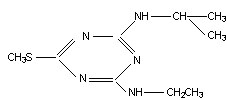|
Ametryn
|
|
Chemical name: |
Ametryn |
|
CAS No.: |
834-12-8
|
|
Empirical formula: |
C9H17N5S
|
|
Structural formula: |
 |
|
Molecular mass: |
227.33 |
|
Basic chemical and physical data: |
The pure Ametryn is white crystal, m.p. 84 – 86℃, vapor pressure 0.365mPa, solubility in water: 185mg/l (20℃); It dissolves readily in organic solvents including hexane, toluene, methanol, and acetone.
This material is stable in normal conditions, but it will decompose in strong acid or strong base, especially at high temperature. This material is non-flammable, non-explosive, and non-corrosive.
|
|
Usage: |
Ametryn is used as a selective triazine herbicide. It is used to control broadleaf weeds and annual grasses in pineapple, sugarcane and bananas. It is used on corn and potato crops for general weed control. It is also used as a vine desiccant on dry beans and potatoes. |
|
Toxicity: |
The acute oral LD50 for rats is 3160mg/kg (female) and 2710mg/kg (male), the acute dermal LD50 for rats is more than 3100mg/kg. |
|
Storage: |
Ametryn shall be stored in a cool, dry and well ventilated place. It should not be stored or transported along with foods. |
|
Package: |
25kg woven bag, or 500kg big-bag, or according to the customer’s requirements. |
|
Attention: |
1. The high temperature and high humidity will enhance the effect of Ametryn. But it will inhabit the growth of sugar cane if the field will be submerged in water.
2. Do not use Ametryn when the earthnut, soybean or vegetable is planted in the field of sugar cane.
3. Ametryn is classified by the WHO as a pesticide unlikely to present acute hazard in normal uses. But people shall protect themselves when they formulate and use Ametryn.
|
|
Formulation: |
50%SC; 80%WP; 80%WDG |
|
|
|
|
Specification of technical: |
|
|
Appearance: Off-white powder
Content of A.I.: 97.0% min.
Content of NaCl: 1.0% max.
Loss on drying: 1.0% max.
Fineness (pass through 325 mesh sieve): 98.0% min. |